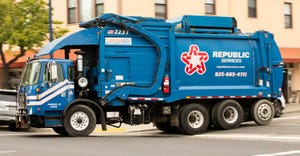COLLECTION: Communities Form Strategies Against Illegal Dumping
January 1, 1995
Jill Slovin
Illegal dumping has always been an underlying fear of solid waste managers. Fortunately, their fears are greater than the number of illegal dumpers, according to a recent study by Skumatz Economic Research Associates (SERA), Seattle.
The costs of solid waste services can be a major determinant of illegal dumping. In fact, just anticipating the act unleashes a plethora of concern for managers seeking to implement program changes, such as variable rates.
Although data on this subject is difficult to obtain, more than 100 communities and haulers have characterized illegal dumping as a temporary problem that they were able to handle, the study found.
Increasing tipping fees and banning certain materials from transfer stations and landfills also can escalate illegal dumping. For example, higher disposal rates at a California regional landfill reportedly caused an increase in illegal dumping, which, in turn, boosted the city's solid waste costs.
In an effort to find the source of illegal dumping, some communities have documented the types of wastes which are most frequently dumped. Construction and demolition debris (C&D), white or bulky goods and organic materials such as yard wastes are the most common materials found at illegal disposal sites. After tipping fees were increased in a British Columbia city, municipal officials conducted a composition study of the materials illegally dumped. Their review led them to recommend a bulky and white goods program within their variable rates structure.
Residents illegally dispose of waste by throwing it into a commercial dumpster, leaving it at roadside or burning it on their own property. Although it is difficult to identify who disposed of the material found in commercial dumpsters, the large containers pose fewer health and environmental concerns than other dumping sites. The location of the materials often dictates which enforcement method MSW managers will use.
Enforcement efforts vary greatly. In some communities, residents call their city to clean up the material. In others, police investigate the pile in an attempt to identify and charge the violator with a fine or the cost of the clean up. Some cities even have hired a staff to enforce dumping regulations. For example, an Illinois community employs three inspectors who issue tickets ranging from $25 to $50; a New York agency has hired a full-time sheriff; and another municipality charges up to $3,000 per incident to cover clean up costs.
In 1992, a California city introduced an enforcement program entitled "We Mean Clean." The program reportedly reduced illegal dumping by 95 percent through the following approaches:
* Undercover Surveillance. Enforcement officers posed as unlicensed haulers or homeless people to arrest unlicensed haulers or other violators caught dumping. A total of 122 arrests were made.
* Fines. Illegal dumpers were fined $500 and in 1993 the city collected $30,000 in fines. Twelve cases were taken to small claims court, but the city won each time.
* Sting Operations. To catch unlicensed haulers, enforcement officials posed as customers needing collection service.
Before a community can fine or prosecute violators, a law must be passed to prohibit illegal dumping. The laws can target landowners, who would be required to clean up the illegally dumped material on their property; generators, who would be held responsible for hiring reputable firms to haul their garbage; or illegal dumpers, who are the most sensible - and hardest - people to target.
Educational campaigns are one way to curtail illegal dumping (see chart). Communities often place signs which read "No dumping, violators will be fined $500," on dumpsters or in areas where illegal dumping occurs.
To prevent illegal dumping, municipal officials should set up flexible solid waste programs. For example, since space was limited at a Washington disposal site, the county prohibited the disposal of yard wastes at the curb but allowed it to be disposed at transfer stations. To prevent the improper disposal of white goods, communities should provide convenient and affordable disposal opportunities.
In Illinois, haulers had problems with illegal dumping when variable rate collection programs had no minimal subscription levels. Once they required residents to subscribe to a minimum amount of service, variable rates had little or no impact on illegal dumping.
To prevent illegal dumping, communities can choose from a wide range of strategies. Whether they choose a passive or very aggressive approach, the goal is to keep the trash where it belongs - in the can.
For a copy of the report, "Illegal Dumping: Incidence, Drivers and Strategies," contact: Lisa Skumatz, Skumatz Economic Research Associates, 1511 Third Ave., Suite 1018, Seattle, Wash. 98101. (206) 624-8508.
You May Also Like


